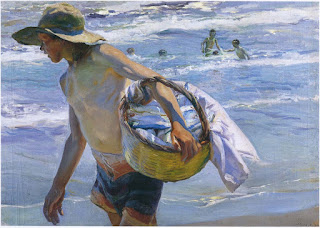Joaquín Sorolla y Bastida - Self Portrait, 1904
Another revelatory exhibition that enlightened me about a less celebrated artist, like that of Harald Sohlberg (here), was discovered in this exhibition at the National Gallery. Unlike Sohlberg though, there are no spiritual 'moods' or 'atmospheres here, just the assured touch, and brilliance of a master who has not achieved the full recognition he possibly deserves. This exhibition perhaps - charting Sorolla's development from social realist painter with a conscience, to a looser impressionistic style - may go some way to redress the balance. Valencian born Joaquín Sorolla y Bastida (1863-1923) was one of those enviously accomplished virtuoso painters whose skills in draughtsmanship, composition and painterly techniques was enough for him to be acclaimed "The World's Greatest Living Painter" at his last London exhibition in 1908. Sorolla may not have had the requisite vision to forge a path as a modernist pioneer like many during that period in the pantheon of art history, but as this show attests his artistic profiency was enough for him to be compared to fellow Spaniards Diego Velázquez and Francisco de Goya. Sorolla was a gifted painter, not afraid of working on a huge scale and able to conjure a variety of dazzling light effects similar to those of the Impressionists (often captured similarly en plein air too), and achieved with an economy of brushstrokes. I was surprised at how fast and loose the brushstrokes were executed in the majority of his paintings, exercising a control and tightening his brush technique only in areas in which he wanted to place emphasis, and concentrate the viewers focus, such as faces (often in his society portraits). This method of painting was reminiscent of the society portraits of those of his friend John Singer Sargent, and also of Gustav Klimt. Sorolla also channels fellow Spaniard Velázquez’s ‘Rokeby Venus’ (1647–51), which he saw on a visit to London in the erotically charged Female Nude, 1902 (below). It is the paintings in which Sorolla captures the sense of heat, as well as the intensity and luminosity of the light of the Spanish heartlands and coast in beach scenes, that helped to forge his reputation. This was a show full of surprises, and Sorolla's body of work merits the renewed interest.
Joaquín Sorolla y Bastida - Another Marguerite!, 1892
Joaquín Sorolla y Bastida - Packing the Raisins, 1900
Joaquín Sorolla y Bastida - The Return From Fishing, 1894
Joaquín Sorolla y Bastida - Mending the Sail,1896
Joaquín Sorolla y Bastida - Sad Inheritance, 1899
Joaquín Sorolla y Bastida - Female Nude, 1902
Joaquín Sorolla - Joaquín Sorolla García, seated, 1917
Joaquín Sorolla y Bastida - Elena in a Yellow Tunic, 1909
Joaquín Sorolla y Bastida - Young Fisherman, Valencia, 1904
Joaquín Sorolla y Bastida - After the Bath, The Pink Robe, 1916
Joaquín Sorolla y Bastida - The Bride From Lagartera,1912
Joaquín Sorolla y Bastida - Couple From Salamanca,1912
Joaquín Sorolla y Bastida - Couple From Salamanca,1912
Joaquín Sorolla y Bastida - Maria Painting at El Pardo,1907
Joaquín Sorolla y Bastida - My Wife and Daughters in the Garden,1910
Joaquín Sorolla y Bastida - The Siesta,1911
Joaquín Sorolla y Bastida - Strolling Along the Seashore,1909
Sorolla: Spanish Master of Light
until 7th July
National Gallery
Trafalgar Square
London























